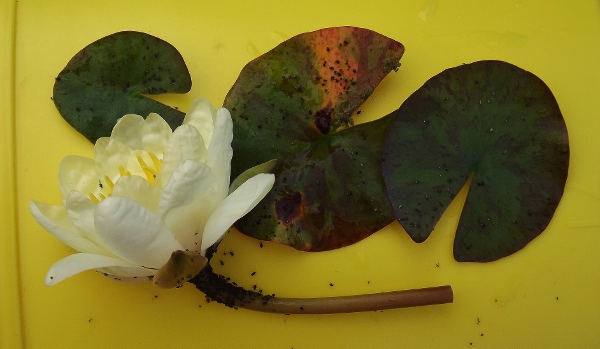Pest and Life Cycle – (Rhopalosiphum nymphaeae) Aphids overwinter as eggs on fruit trees, usually members of the Prunus genus. They hatch in spring as wingless females and keep reproducing. With the onset of warmer weather some of the females develop wings and migrate to feed on other plants, such as water lilies. They travel back to the plants they overwinter on late in the season and lay fertilized eggs for next year’s generation. Waterlily Aphid also feeds on marginal plants such as Typha (Cattail), Sagittaria (Arrowhead) and Pontederia (Pickerel Weed) and is capable of walking on the surface of the water.
Symptoms – Waterlily Aphids are sucking insects which attack both leaves and flower stems (particularly those above the water surface) and may cause premature yellowing, distortion or stunted growth. They are even capable of feeding underwater by crawling down stems and trapping air with specialized hairs on their bodies.
Management – Knock the aphids off plant parts using a hard spray from the garden hose. Once they are in the water, Koi and Goldfish with readily feed on them. If you do not have any, consider purchasing a few inexpensive feeder fish (also good for eating mosquito larvae) for this purpose. Do not use pesticides or oil-based products in your pond (particularly those with Pyrethrin, which is highly toxic to fish), as these can adversely affect the aquatic environment. If only a few leaves are affected, they can be removed entirely and discarded.
Prevention – 1. Monitor your waterlilies, marginals and plants around your pond frequently, as it is much easier to deal with a minor infestation. 2. Treat nearby fruit trees (particularly Prunus fruits such as cherry and plum) with dormant oil to kill overwintering aphid eggs.




